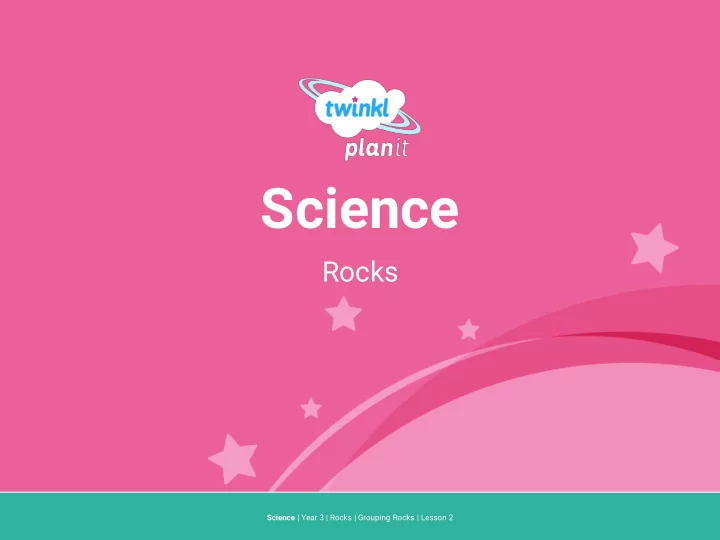

Science Rocks Science | Year 3 | Rocks | Grouping Rocks | Lesson 2
Aim • I can group rocks based on their properties. • I can make systematic and careful observations. Success Criteria • I can name the different types of rocks. • I can identify features of different rocks. • I can group rocks by specific criteria. • I can handle and examine rocks carefully. • I can use a systematic approach to recognise similar features of different rocks.
Types of Rocks What are the three types of rocks? What causes them to be different? Igneous Sedimentary Metamorphic Formed under the sea Metamorphic rocks are as a result of igneous or sedimentary Formed from magma sedimentation, or rocks that change or lava. chemically due to proximity to magma, huge pressure from compaction and burial or changes in cementation. tectonic plates.
Describing Rocks What adjectives would you use to describe rocks? Discuss with your talk partner.
Properties of Rocks The following are a list of common properties of rocks: Hard or Soft Permeable or Impermeable Some rocks, like granite, are incredibly If a rock is permeable, for hard and can only be cut or split with example pumice, this means it specialist tools. On the other allows water to pass through it. hand, clay is soft and can be Rocks that are impermeable do easily moulded. not allow water to pass through. Durable Density Rocks that are durable are more Density measures how ‘bulky’ the rock is resistant to weathering (being eroded – (how tightly packed the molecules are), not that is broken down – by rain and how heavy. Density can be checked by wind). More durable rocks, such as testing the buoyancy (whether they float in marble, have been chosen to create water) of rocks. High density rocks sink buildings and for outside use for this whereas low density rocks float. reason.
Carousel of Activities Books Group Permeability and Durability Group You will use books to find out about This group will test rocks to see if they are permeable and/or durable. the properties of rocks. Density Group You will be testing the buoyancy of different rocks to find out how dense they are.
Grouping Rocks Record your observations and take notes on your Properties of Rocks Activity Sheet.
Grouping Rocks You will now use the notes you have taken on the Properties of Rocks Activity Sheet to group rocks based on their properties.
Aim • I can group rocks based on their properties. • I can make systematic and careful observations. Success Criteria • I can name the different types of rocks. • I can identify features of different rocks. • I can group rocks by specific criteria. • I can handle and examine rocks carefully. • I can use a systematic approach to recognise similar features of different rocks.
Recommend
More recommend